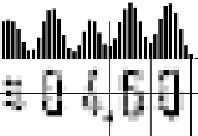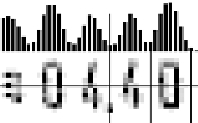Information Technology Reference
In-Depth Information
Position Normalization.
The block recognizer, described below, has an input size
of 32
×
16. A window of this size must be cut from the region of interest. Since the
block recognizer has to read the two digits directly to the left and to the right of
the point or space delimiting kronor from ore, the window is placed such that the
gap between these two digits is centered horizontally. Figure 7.7(b) illustrates how
the space between the second and the third digit from the right is found using a
smoothed occupancy index that is computed for each column.
The occupancy index is the sum of two components: the column's foreground
sum and its top index, as shown in Fig. 7.7(a). To determine the top index, a col-
umn's foreground values are accumulated, starting from the topmost row, until the
sum exceeds 128. The top index is proportional to the height of this first occurrence
of significantly dark foreground decreased by three. This accounts for the delimiting
point that is usually located in the lower three rows, which should not cause high
top indices.
The occupancy index is smoothed with a binomial kernel of size 9 to reduce the
number of local minima. Each digit should now correspond to a single maximum
while each space between digits should correspond to a single local minimum. Start-
ing from the right, the beginning of the digits is localized in the occupancy vector.
The search then proceeds to find the first and the second local minimum between
the digits (see marked columns in the figure).
(a)
(b)
(c)
(d)
Fig. 7.7.
Position normalization. For the examples from Fig. 7.5 are shown: (a) top index
(upwards) and column sum (downwards); (b) region of interest with smoothed occupancy
index (the start column at the right, as well as two local minima and the vertical center of
mass are marked); (c) 32
×
16 window cut from the region of interest; (d) window with faded
borders.












Search WWH ::

Custom Search